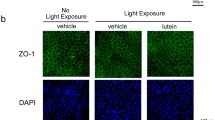Abstract
In a mouse model of acute light-induced retinal degeneration, positive correlations between the levels of DHA, the levels of n3 PUFA lipid peroxidation, and the vulnerability to photooxidative stress were observed. On the other hand, higher sensitivity of the electroretinogram a-wave response, a measure of the amplification of the phototransduction cascade, was correlated with higher retinal DHA levels. These results highlight the dual roles of DHA in cellular physiology and pathology.
Access this chapter
Tax calculation will be finalised at checkout
Purchases are for personal use only
Similar content being viewed by others
References
Anderson RE, Penn JS (2004) Environmental light and heredity are associated with adaptive changes in retinal DHA levels that affect retinal function. Lipids 39:1121–1124
Awasthi YC, Yang Y, Tiwari NK et al (2004) Regulation of 4-hydroxynonenal-mediated signaling by glutathione S-transferases. Free Radic Biol Med 37:607–619
Benolken RM, Anderson RE, Wheeler TG (1973) Membrane fatty acids associated with the electrical response in visual excitation. Science 182:1253–1254
Birch DG, Birch EE, Hoffman DR et al (1992) Retinal development in very-low-birth-weight infants fed diets differing in omega-3 fatty acids. Invest Ophthalmol Vis Sci 33:2365–2376
Bush RA, Reme CE, Malnoe A (1991) Light damage in the rat retina: the effect of dietary deprivation of N-3 fatty acids on acute structural alterations. Exp Eye Res 53:741–752
Bush RA, Malnoe A, Reme CE et al (1994) Dietary deficiency of N-3 fatty acids alters rhodopsin content and function in the rat retina. Invest Ophthalmol Vis Sci 35:91–100
De La Paz MA, Anderson RE (1992) Lipid peroxidation in rod outer segments. Role of hydroxyl radical and lipid hydroperoxides. Invest Ophthalmol Vis Sci 33:2091–2096
Fliesler SJ, Anderson RE (1983) Chemistry and metabolism of lipids in the vertebrate retina. Prog Lipid Res 22:79–131
Jeffrey BG, Mitchell DC, Gibson RA et al (2002) n-3 fatty acid deficiency alters recovery of the rod photoresponse in rhesus monkeys. Invest Ophthalmol Vis Sci 43:2806–2814
Kang JX, Wang J, Wu L et al (2004) Transgenic mice: fat-1 mice convert n-6 to n-3 fatty acids. Nature 427:504
Koutz CA, Wiegand RD, Rapp LM et al (1995) Effect of dietary fat on the response of the rat retina to chronic and acute light stress. Exp Eye Res 60:307–316
Mitchell DC, Niu SL, Litman BJ (2003) Enhancement of G protein-coupled signaling by DHA phospholipids. Lipids 38:437–443
Morrison WR, Smith LM (1964) Preparation of fatty acid methyl esters and dimethylacetals from lipids with boron fluoride–methanol. J Lipid Res 5:600–608
Niu SL, Mitchell DC, Lim SY et al (2004) Reduced G protein-coupled signaling efficiency in retinal rod outer segments in response to n-3 fatty acid deficiency. J Biol Chem 279:31098–31104
Organisciak DT, Darrow RM, Jiang YL et al (1996) Retinal light damage in rats with altered levels of rod outer segment docosahexaenoate. Invest Ophthalmol Vis Sci 37:2243–2257
Organisciak DT, Darrow RM, Jiang YI et al (1992) Protection by dimethylthiourea against retinal light damage in rats. Invest Ophthalmol Vis Sci 33:1599–1609
Spychalla JP, Kinney AJ, Browse J (1997) Identification of an animal omega-3 fatty acid desaturase by heterologous expression in Arabidopsis. Proc Natl Acad Sci U S A 94:1142–1147
Tanito M, Anderson RE (2006) Bright cyclic light rearing-mediated retinal protection against damaging light exposure in adrenalectomized mice. Exp Eye Res 83:697–701
Tanito M, Kaidzu S, Anderson RE (2007) Delayed loss of cone and remaining rod photoreceptor cells due to impairment of choroidal circulation after acute light exposure in rats. Invest Ophthalmol Vis Sci 48:1864–1872
Tanito M, Elliott MH, Kotake Y et al (2005) Protein modifications by 4-hydroxynonenal and 4-hydroxyhexenal in light-exposed rat retina. Invest Ophthalmol Vis Sci 46:3859–3868
Tanito M, Yoshida Y, Kaidzu S et al (2006a) Detection of lipid peroxidation in light-exposed mouse retina assessed by oxidative stress markers, total hydroxyoctadecadienoic acid and 8-iso-prostaglandin F(2alpha). Neurosci Lett 398:63–68
Tanito M, Brush RS, Elliott MH et al (2009) High levels of retinal membrane docosahexaenoic acid increase susceptibility to stress-induced degeneration. J Lipid Res 50(5):807–819
Tanito M, Haniu H, Elliott MH et al (2006b) Identification of 4-hydroxynonenal-modified retinal proteins induced by photooxidative stress prior to retinal degeneration. Free Radic Biol Med 41:1847–1859
Toyokuni S (1999) Reactive oxygen species-induced molecular damage and its application in pathology. Pathol Int 49:91–102
Tytell M, Barbe MF, Gower DJ (1989) Photoreceptor protection from light damage by hyperthermia. Prog Clin Biol Res 314:523–538
Uchida K, Stadtman ER (1992) Modification of histidine residues in proteins by reaction with 4-hydroxynonenal. Proc Natl Acad Sci U S A 89:4544–4548
Wheeler TG, Benolken RM, Anderson RE (1975) Visual membranes: specificity of fatty acid precursors for the electrical response to illumination. Science 188:1312–1314
Wiegand RD, Giusto NM, Rapp LM et al (1983) Evidence for rod outer segment lipid peroxidation following constant illumination of the rat retina. Invest Ophthalmol Vis Sci 24:1433–1435
Wiegand RD, Koutz CA, Stinson AM et al (1991) Conservation of docosahexaenoic acid in rod outer segments of rat retina during n-3 and n-6 fatty acid deficiency. J Neurochem 57:1690–1699
Winkler BS, Boulton ME, Gottsch JD et al (1999) Oxidative damage and age-related macular degeneration. Mol Vis 5:32
Acknowledgments
Financial support from the Foundation Fighting Blindness, Research to Prevent Blindness, Inc., the National Eye Institute (EY12190, EY04149, and EY00871), and National Center for Research Resources (RR17703) is gratefully acknowledged.
Author information
Authors and Affiliations
Corresponding author
Editor information
Editors and Affiliations
Rights and permissions
Copyright information
© 2010 Springer Science+Business Media, LLC
About this chapter
Cite this chapter
Tanito, M., Brush, R.S., Elliott, M.H., Wicker, L.D., Henry, K.R., Anderson, R.E. (2010). Correlation Between Tissue Docosahexaenoic Acid Levels and Susceptibility to Light-Induced Retinal Degeneration. In: Anderson, R., Hollyfield, J., LaVail, M. (eds) Retinal Degenerative Diseases. Advances in Experimental Medicine and Biology, vol 664. Springer, New York, NY. https://doi.org/10.1007/978-1-4419-1399-9_65
Download citation
DOI: https://doi.org/10.1007/978-1-4419-1399-9_65
Published:
Publisher Name: Springer, New York, NY
Print ISBN: 978-1-4419-1398-2
Online ISBN: 978-1-4419-1399-9
eBook Packages: Biomedical and Life SciencesBiomedical and Life Sciences (R0)




